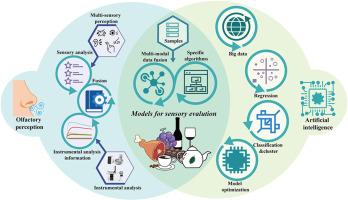Artificial intelligence for flavor perception: Integrating olfactory mechanisms into food group sensory evaluation
IF 15.4
1区 农林科学
Q1 FOOD SCIENCE & TECHNOLOGY
引用次数: 0
Abstract
Background
Flavor constitutes a pivotal determinant of food quality and sensory experience, with its evaluation conventionally relying on assessors and instruments. However, traditional approaches encounter significant challenges in terms of objectivity, efficiency, economic costs and throughput. In recent years, artificial intelligence (AI) offers novel methodologies and solutions to these bottlenecks.
Scope and approach
This paper presents a systematic review of AI-driven models for food group sensory evaluation, with particular emphasis on integrating flavor perception mechanisms, especially olfaction, into group sensory analysis. Furthermore, drawing from interdisciplinary perspectives including perceptual science, computational intelligence, and flavor-omics, it conducts an in-depth analysis of constructing models and its practical implementation. Particularly, grounded in the principles of olfactory perception, the review investigates recognition mechanism of flavor compounds and explores strategies to AI-driven flavor prediction, quality grading, and mechanistic interpretation.
Key findings and conclusions
Compared with traditional methods, AI-driven olfactory perception evaluation methods have greatly improved the analysis of differences within and between groups, efficiency, insight into flavor substances, and analysis of high-throughput and high-modal data. In addition, combined with specific algorithms and models, interpretability analysis and flavor prediction can be realized on the basis of sensory evaluation, holding strong promise for broader adoption in food science.

风味感知的人工智能:将嗅觉机制整合到食物群感官评价中
风味构成了食品质量和感官体验的关键决定因素,其评估传统上依赖于评估人员和仪器。然而,传统方法在客观性、效率、经济成本和吞吐量方面遇到了重大挑战。近年来,人工智能(AI)为这些瓶颈提供了新的方法和解决方案。本文对人工智能驱动的食品群体感官评价模型进行了系统综述,特别强调了将风味感知机制,特别是嗅觉,整合到群体感官分析中。此外,从感知科学、计算智能和风味组学等跨学科视角,深入分析了构建模型及其实际实现。本文特别以嗅觉感知原理为基础,研究了风味化合物的识别机制,并探讨了人工智能驱动的风味预测、质量分级和机制解释策略。与传统方法相比,人工智能驱动的嗅觉感知评估方法大大提高了对群体内和群体间差异的分析、效率、对风味物质的洞察以及对高通量和高模态数据的分析。此外,结合具体的算法和模型,可以在感官评价的基础上实现可解释性分析和风味预测,在食品科学中有更广泛的应用前景。
本文章由计算机程序翻译,如有差异,请以英文原文为准。
求助全文
约1分钟内获得全文
求助全文
来源期刊

Trends in Food Science & Technology
工程技术-食品科技
CiteScore
32.50
自引率
2.60%
发文量
322
审稿时长
37 days
期刊介绍:
Trends in Food Science & Technology is a prestigious international journal that specializes in peer-reviewed articles covering the latest advancements in technology, food science, and human nutrition. It serves as a bridge between specialized primary journals and general trade magazines, providing readable and scientifically rigorous reviews and commentaries on current research developments and their potential applications in the food industry.
Unlike traditional journals, Trends in Food Science & Technology does not publish original research papers. Instead, it focuses on critical and comprehensive reviews to offer valuable insights for professionals in the field. By bringing together cutting-edge research and industry applications, this journal plays a vital role in disseminating knowledge and facilitating advancements in the food science and technology sector.
 求助内容:
求助内容: 应助结果提醒方式:
应助结果提醒方式:


